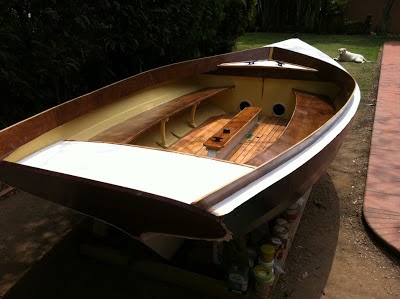 |
| Mr Wong and Mr Kwong, stir frying the lead, in the back-streets of Kowloon
It's been a while since the last post. I've not been idle (well... not too idle...), just that I wasn't sure how I was going to make the lead ballast-keel for this little Somes Sound 12 1/2. Both Dave in California and Embla in Ireland (links at right) managed to cast the keel well enough, so that was an inspiration.
But here in Hong Kong, I faced a peculiar challenge: first, that there's very little scrap lead around -- most is immediately shipped to China. Second: that there's no foundry that's willing to melt lead: again, that's all moved to China. So I had various versions of Plans A, B and C....*
Plan B was to do the pour at my place in Discovery Bay, but at the last minute, and thanks to yachting mate Frank Pong, I got the address of a little place in Tai Kok Tsui, in the back-blocks of Kowloon, who, Frank said, would be willing to melt and pour up to 300kg of lead. So revert to Plan A, version 3.0....
So, off I head to meet up with Mr Kwong, who doesn't speak English, but does speak some Mandarin (which I speak), so we got along fine, though his Mandarin is what I'd call "Canto-rin" -- heavily Cantonese-accented Mandarin.
Courtesy of neighbour Steve, who has a van (and who helped me with the first lamination of the inner stem), we took the mold to Mr Kwong Friday a week ago (26 April), and set Monday last (29th April) as the day to do the melt and pour.
Result: GREAT!
It started slow to be sure, and I wondered at one stage if we were going to have to give up. Mr Kwong only using flame from above and one little bottle like you use for the lamb hotpot. I said flame was needed below (industrial strength restaurant-style) and though he agreed, he didn't do anything about it, as he obviously didn't have the requisite gear. So he headed off round the corner and came back with another large gas bottle and flame thrower and with that, managed to melt the lead in reasonable time.
The lead was poured into the mold with Mr Kwong's soup ladle... it worked fine!
We kept at it: pouring ladles of lead into the mold and melting bits of lead as quickly as possible so that the lead in the mold wouldn't be too hard -- if it gets too hard, the next layer poured in the mold won't "stick" to the one below.
We kept at it until the lead was up to the line I'd scribed on the mold for the highest level of lead. Also, we'd pre-measured 265 kg of scrap lead and that was what we melted. All of it.
It was starting to look good when the amount of lead we'd measured and melted matched exactly the line I'd marked on the mold.
Then we weighed it on Mr Kwong's scales: 265 kg was the design weight. The actual weight: 263.99 kg! Pretty good, I'd say!
Photos follow...
|
 |
| This is Mr Kwong's shop, Sheung Yip, 72 Oak St, Tai Kok Tsui, Kowloon. The area is all metal. Mr Kwong has lead, rolls, scrap, lumps; Zinc; Aluminium... |
 |
| Mr Kwong burns the lump of lead scrap, while Mr Wong gets ready to funnel sand into the copper tubes: to stop the bubbling in of lead, which Dave said was a problem when he cast his keel. |
 |
| And here we are creating the new dish -- "Keel Foo Yung". Using restaurant utensils: a huge Wok, spatula, slotted spoon, soup ladle... |
 |
| Measuring the weight. (the mold had been pre-weighed). After a bit of arithmetic: find that we're about 1kg within design weight. I'm stoked! |
Thumbs up! Mr Kwong, Mr Wong, and our Noel, celebrate the
successful pour.
|
* Plan A: find a foundry in Hong Kong to melt and pour the lead.
Plan B: melt and pour the lead at home.
Plan C: forget about lead: throw a bunch of stones in the bottom of the boat, like the Vikings did in their longboats.





